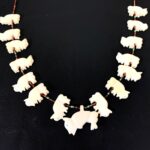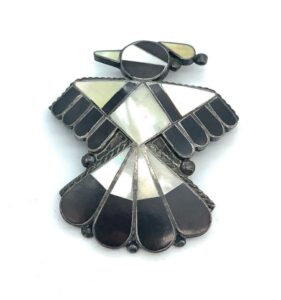class=”text-uppercase mb-5 text-yellow-sea innerpage-title”>Meanings Behind the Stones Part II: Understanding Popular Native American Jewelry Designs
Native American jewelry items take pride in their beauty and rich history. People get captivated by their designs that seem to narrate the lore of the past. From the Navajo’s squash blossom necklace to the Zuni’s fetish carving, these personal adornment items are testaments to man’s pursuit of beauty and meaning to his existence.
Accordingly, people wear these prized items not just for their aesthetic value but also for their historical significance. Native American artists put their heart into crafting the best jewelry pieces on the market, and it’s only fair that consumers wear these Native American accessories knowing the real meanings behind each design.
To help you appreciate your most favored jewelry items even more, below is the continuation of our brief guide to knowing the meanings behind each design. (Read: Meanings Behind the Stones: Understanding Popular Native American Jewelry Designs)
Popular Native American Jewelry Designs and Their Meanings
To continue our list from the previous article, here are other popular designs in Native American jewelry and their meanings. Check them out below:
- Buffalo

Buffalo symbols are prevalent among many Native American jewelry items. Rings, pendants, and bracelets made by Native peoples are found exhibiting whole images of buffalos or distinct features of the animal, such as their horns and skulls. Generally, there are many reasons for these designs.
For one, the buffalo played an integral part in the survival of the Native Americans. Hence, the Indigenous peoples treat them with much respect to the point that they replicate the image of the animal in their personal items.
The animal is so deeply entrenched in the history of the Native Americans that it forms part in the making of the history of the Plains Indians or those that lived in North America’s Great Plains.
Thousands of years ago, there was not much food available in the said region. To survive, the Native peoples relied on buffalos, more accurately called bison, for their day-to-day needs. They hunted the said animal for food, used its horns and bones for making weapons, and collected its skin and fur for clothing. Every part of the buffalo became a means for the Native peoples to survive.
Unsurprisingly, the presence of buffalo figures in their accessories is meant to symbolize man’s perseverance to survive. It represents strength and even humility, an acknowledgment of man’s dependence on nature in order to live.
- Sun / Sun rays

The sun is another common symbol in Native American jewelry items, and its meaning varies from tribe to tribe.
Generally, the sun is revered by Native Americans. It has all the features reminiscent of divinity: it is always there, it is untouchable yet can be felt on the skin, it gives light, and it enables crop growth. The Plains Indians, in particular, even dedicate a yearly religious ceremony in honor of the sun called the Sun Dance. The ritual involves members of a tribe dancing and fasting for days around a central pole. In some tribes, participants are fastened to the pole using wooden or bone skewers, like sun rays. It is essentially a sacred ceremony and is equivalent to self-sacrifice for the good of the community.
Overall, the sun served as the symbol of man’s connection with the supernatural. Native American tribes came up with their own versions of sun symbols in their jewelry items. For example, the Navajo tribe designs their sun with curved rays. This symbolizes the sun as the giver of life and energy. The Zuni tribe, on the other hand, designs their suns with a face to represent warmth and happiness.
- Feathers
One cannot talk about Native American arts and cultures without mentioning feathers and their role in the Native peoples’ history. Generally, feathers are considered a powerful symbol to the Indigenous peoples. Its religious and cultural value roots from the Native American’s belief that birds of different kinds have a connection with the heavens. Accordingly, if their feather falls to the ground, it serves as a direct gift from the gods to someone deserving of such an honor, and it carries the energy of the bird from whom the feather came.
Different meanings are also attached to feathers that come from other birds. Eagle feathers are looked at with high regard and given the highest honor. Only those that demonstrated commendable bravery are given eagle feathers. Meanwhile, owl feathers are used to symbolize wisdom. Hawk feathers signify guardianship and protection. They are used and worn to ward off dangers and evil. The feathers of a falcon represent speed, vision, and decisiveness.
- Thunderbird

The thunderbird is a popular figure in Native American mythology and a common symbol in many Native American jewelry items. The mythological creature is said to be a god in a bird form and is described to be huge with brightly colored feathers and horns. As it flaps its wings, you can hear the thunder rolling. It can control the weather and can produce lighting from its beak.
The Native Americans see the Thunderbird with great respect and fear. Many tribes believe sighting a Thunderbird tells something about your destiny. The Lakota Sioux, for example, believe that seeing a Thunderbird implies that one is destined to become a sacred clown. The Winnebago tribe, on the other hand, believes that seeing the sacred bird during a solitary fast means the person will become a war chief.
Thunderbird symbols, therefore, represent glory, power, and even luck.
Pawn/Sell Your Native American Jewelry
Every jewelry item has its story to tell. In the case of Native American jewelry, every symbol reflects man’s coexistence with nature and how he interprets this relationship.
If you own any authentic Native American jewelry piece, you can share its beauty and rich history by selling the piece to us here at Biltmore Loan and Jewelry. Simply contact us through our website or you can visit our 2 locations (Scottsdale and Chandler). No appointments necessary!
Ten articles before and after
Recap: Biltmore Loan will find the value of your items| CHURINGA RUBY JEWELRY
5 Reasons to Choose Biltmore Loan Over Craigslist| CHURINGA RUBY JEWELRY
Value of Rare Coins: How Much Is Your Nickel Worth?| CHURINGA RUBY JEWELRY
Art History Timeline Part 3: Emergence of Contemporary Art| CHURINGA RUBY JEWELRY
Navajo, Hopi, and Zuni: Tracing the Origins of your Native American Jewelry| CHURINGA RUBY JEWELRY
Silver or Gold: A Guide to Choosing the Right Metal| CHURINGA RUBY JEWELRY
Money That Sells: 8 Prized U.S. Coins in Circulation| CHURINGA RUBY JEWELRY
What's It Worth On Sonoran Living Live January 11, 2017 Part 2| CHURINGA RUBY JEWELRY
Beginner's Mistake: 7 Errors Coin Collectors Should Avoid| CHURINGA RUBY JEWELRY